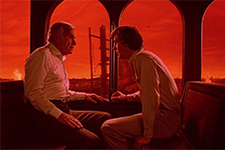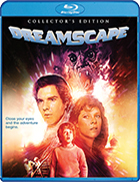Dreamscape
|  Joseph Ruben’s Dreamscape was one of two independently produced films released in 1984—the other being Wes Craven’s A Nightmare on Elm Street—whose primary action was set in the surreal, uninhibited world of dreams. Craven’s film would, of course, go on to spawn a multi-decade franchise, mostly due to the popularity of the film’s scarred, cackling villain Freddy Krueger. Ruben’s film did not do nearly as well, partially because it was released in the dog days of late summer, when popcorn-movie fatigue had set in after the massive studio-produced blockbusters Indiana Jones and the Temple of Doom, Gremlins, Ghostbusters, and Beverly Hills Cop. Dreamscape’s wild mix of genres (It’s a horror film! It’s a fantasy! It’s science fiction! It’s a political thriller!) made it difficult to market. It didn’t make much impact at the theatrical box office, winding up 70th for the year, although it went on to a long life on home video and cable (which is where I saw it dozens and dozens of times as kid), thus ensuring it an enduring cult fandom. Dennis Quaid, whose career as a leading man was just taking off with star turns in Tough Enough (1983) and Jaws 3-D (1983), stars as Alex Gardner, a wily and arrogant young psychic who is recruited by Dr. Paul Novotny (Max von Sydow), his former mentor on whom he ran out nine years earlier, to participate in a top-secret government-fundd research program involving “dreamlinking,” in which psychics, with a little help from technology, are able to enter other people’s dreams. Alex is reluctant at first, as he is more than content to use his gifts for womanizing and making money at the racetracks, but he is ultimately convinced to participate, at least partially because of the involvement of Dr. Jane DeVries (Kate Capshaw), Novotny’s colleague on whom he immediately feels a romantic fixation. The other psychic involved in the program is Tommy Ray Glatman (David Patrick Kelly), a chiseled, beady-eyed psychopath who immediately sees Alex as competition. The program is being overseen by a powerful government agent named Bob Blair (Christopher Plummer), whose insidious underlying motives have much less to do with science and much more to do with using dreamlinking as a means of assassinating threats to the state, including the U.S. President (Eddie Albert), whose constant nightmares about nuclear apocalypse are driving him toward pacificism and disarmament. The screenplay by David Loughery (who originally concocted the story), producer Chuck Russell, and director Joseph Ruben stages different dream sequences as plays on various film genres. One of the most memorable sequences finds Alex entering the dreamworld of a young boy named Buddy (Cory “Bumper” Yothers, younger brother of Family Ties star Tina Yothers), who is plagued by nightmares of a boogeyman that looks like a reptilian humanoid with a cobra head. Alex and Buddy make their way through a skewed nightmare world that draws heavily on stylized German Expressionism. The film’s visual effects are certainly dated, with the Snakeman effects by Craig Reardon—which include both an animatronic suit and stop-motion animation—betraying the budgetary and technological limitations of early ’80s independent filmmaking. Yet, it still works, partially because we know we’re in the world of a child’s dream, which doesn’t necessitate absolute “realism” (the nightmare’s best moment involves a twisted, rickety staircase descending into total darkness, and it also gets great mileage from effects as simple as strobe lights). In another sequence, Alex enters the comical dreamworld of a nebbish (Larry Gelman) who is subconsciously terrified that his wife is having an affair, which leads to the carnivalesque discovery of her in bed with not just his brother, but all his golfing buddies, a Catholic priest, and his Japanese gardener. Threaded throughout all these stylistically and tonally disparate dream sequences is a political plot involving Bob Blair’s desire to assassinate the President in order to protect the country’s nuclear power, which draws together all manner of Reagan-era anxieties involving clandestine government operatives, the arms race, and the ever-present fear of the Cold War suddenly and irreparably heating up into all-out nuclear war. Nuclear fears had been dramatized several films immediately preceding Dreamscape, including the documentary The Atomic Cafe (1982), which assembled clips from American propaganda films of the ’40s and ’50s assuring the populace about the nuclear threat; the thriller WarGames (1983), in which Matthew Broderick’s teenage hacker almost starts World War III; the made-for-television movie The Day After (1983), which envisioned what a nuclear attack on the U.S. would look like; and Testament (1983), a subtle drama about a family trying to hold themselves together after such an attack. Dreamscape lays on the nuclear horrors by both recycling familiar footage of nuclear tests that shows houses and trees being obliterated and creating hellish, decimated landscapes using matte paintings and miniatures. The film’s visual horrors are underscored and accentuated by its seething underbelly of abusive government power, which makes it an obvious descendent of the paranoid strain of ’70s political thrillers like The Parallax View (1974) and Three Days of the Condor (1975). Despite Dreamscape being an independently produced film with a relatively low budget, producer Bruce Cohn Curtis (Roller Boogie, Hell Night) was able to assemble an impressive team of collaborators both in front of and behind the camera. As noted earlier, Quaid’s affable, everyman charms had recently led him to leading man status after nearly a decade of supporting roles (critic Roger Ebert perfectly described him as an “open-faced specialist in crafty sincerity”), and he is ably flanked by well-regarded veterans Max von Sydow and Christopher Plummer, both of whom lend the film an additional air of weight. Kate Capshaw’s presence was certainly enhanced by the release earlier that summer of Indiana Jones and the Temple of Doom, although it also subconsciously contributed to the misplaced notion that the film was somehow an Indiana Jones knockoff (the Drew Struzan-drawn movie poster added to that impression, as well). Curtis was able to wrangle multi-Oscar-winning composer Maurice Jarre, who contributed his first electronic score; editor Richard Halsey, who had won an Oscar for his work on Rocky (1976); and British cinematographer Brian Tufano, who had shot Franc Roddam’s Quadrophenia (1979) and The Lords of Discipline (1983) and would go on to shoot Danny Boyle’s first features Shallow Grave (1994), Trainspotting (1996), and A Life Less Ordinary (1997). And, although many of the special effects look “cheesy” by today’s standards, they are actually a case study in maximizing limited means by employing virtually every trick in the book—from forced perspective miniatures, to optical effects, to extreme camera lenses, to full-scale make-up effects and animatronics. The effects team was supervised by Craig Reardon, who had worked on Tobe Hooper and Steven Spielberg’s Poltergeist (1982) and would go on to win multiple Emmys for his work on Star Trek: Deep Space Nine and The X Files, and their work is generally solid; even when the effects betray their limits, they work within the confines of the film’s various dream worlds. On a historical note, Dreamscape was one of the first films to be assigned a PG-13 rating by the MPAA’s Classification and Ratings Administration. The new rating, which remains the only complete new rating to be added to the system since its inception in November 1968, had been formally announced in June 25, 1984, although there had been internal debates about creating it since the mid-1970s (its creation was accelerated by the parental furor that surrounded the PG-rated Temple of Doom and Gremlins, released in late May and early June, respectively). All films submitted after July 1 were eligible for the new rating; Red Dawn, released on August 10, was the first to be released theatrically with the PG-13 rating, followed by Dreamscape and The Woman in Red a week later. Like a number of those early PG-13 films, Dreamscape was initially rated R, which is not surprising given its frightening imagery, sometimes intense tone, explicit sexuality, and graphic violence (including a man’s heart being ripped from his chest and another being skewered through the back with a steel pipe), and some slight re-editing (mostly of nudity) allowed it to slide under the PG-13 banner. That re-rating arguably enabled its eventual cult status by making it more available to kids like myself, who discovered it in heavy rotation on HBO and Showtime in the mid-’80s. And, while I can’t say it affects me quite as much now as it did then, it still works as a diverting, enjoyably creative thriller.
Copyright © 2017 James Kendrick Thoughts? E-mail James Kendrick All images copyright © Shout! Factory | |||||||||||||||||||||||||||||||
Overall Rating: 

 (3)
(3)


